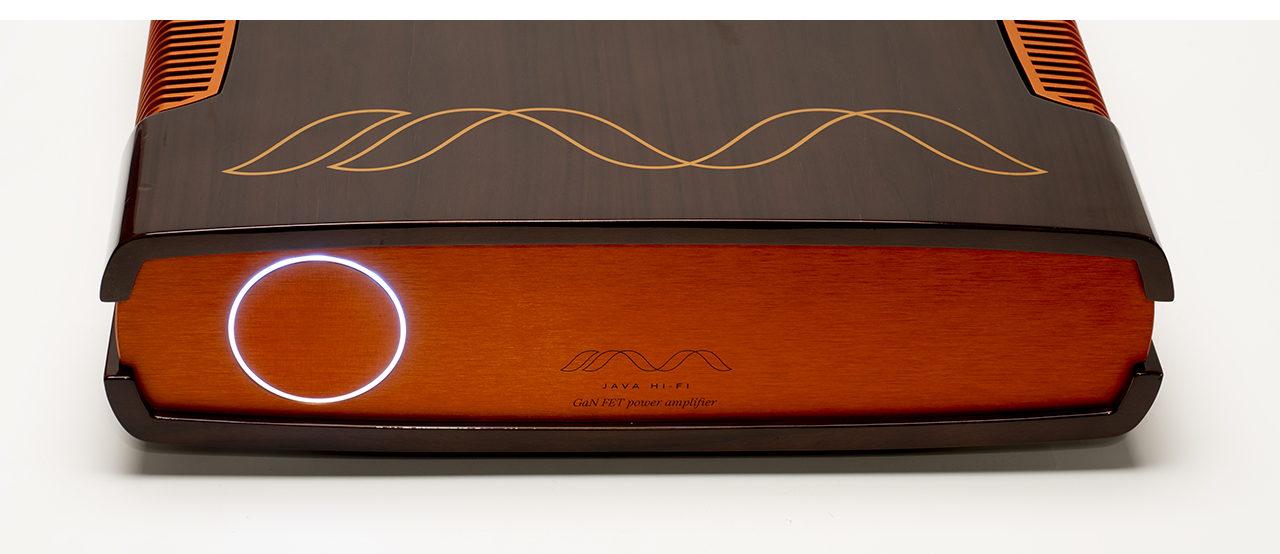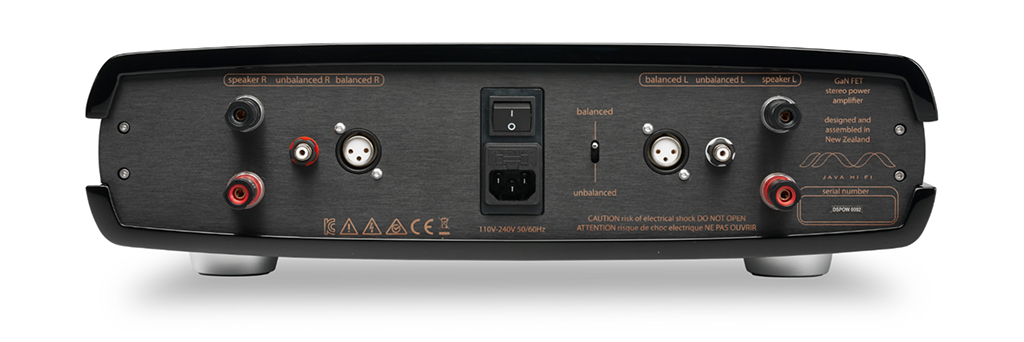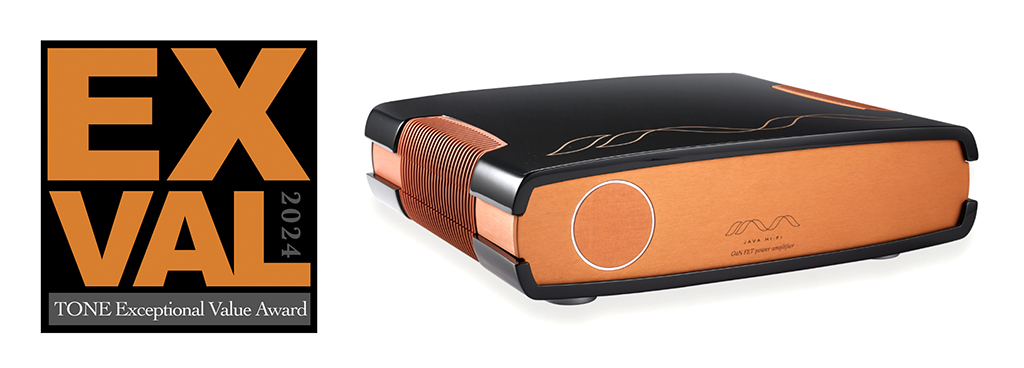The Java Double Shot Power Amplifier Another winner from the barista of High End Audio
By Jeff Dorgay
From the click of the super stylish power button that merely needs your touch to illuminate a diffuse white circle of light, the Double Shot power amplifier from Java gets you going.
To illustrate just how serious I am, listening begins with Jon Astley’s “Jane’s Getting Serious” on 12-inch maxi-single no less. Those Yamaha DX7 keyboard pitch bends never sounded better. This amplifier, is excellent in every way.
So lovely, in fact, that when tracking through BTO’s “Blue Collar,” I’m not even wishing for more cowbell. If that’s not musical perfection, what is? While the amplifier delivers more in spatial terms once it’s been on for about an hour, the tight, coherent musical pace delivered is stellar. Good as the Double Shot integrated is, the power amplifier takes clarity and pace further, because of its larger, dedicated power supply.
It is a magnificent experience to play the Peak Consult Sinfonias at a high volume level, taking advantage of the sheer dynamics these speakers are capable of with enough power. Having mighty monoblocks from Pass Labs (X600.8s – 600 WPC), the PS Audio BHK Signature monos (also 600 WPC), and the PrimaLuna EVO 400 monos (almost 200 WPC with KT150 tubes) all offer their own sonic portrait. Being able to achieve a sizeable amount of the three-dimensional characteristics that the tubes offer, with the sheer sonic slam and control that the big solid-state amplifiers deliver in the compact box that is the Java Double Shot, is nothing short of amazing.
Martin Bell, owner of Java HiFi, sent us his Single Shot integrated amplifier last year, which was fantastic. Fantastic in the same way that we’re not saying “it sounds pretty good for class-D,” like we used to say “it sounds pretty good for digital” when referring to the world’s finer DACs. It just sounds fantastic. Like some of the current crop of class-D designs adopting GaN FET topology, the Single Shot (and all the Java amplifiers) brings a natural, un-electronic sonic signature to the presentation. Eyes closed, you might think you were listening to a Boulder or Constellation amplifier. I pick these two premium designs as a comparison, because in the range of all the amplifier data points in my experience bank, these two have the least colored tonality in either direction. The current crop of Audio Research vacuum tube amplifiers are also in this dimension, but we all know the care, feeding, and cooling requirements of tubes.
It’s not what it used to be
Class D has always promised to be the best of all worlds: high power, high efficiency, and lighter weight. Until just recently, this was the case except for the flat, somewhat harsh, and moderately to severely uninvolving sonics, at least in terms of the best amplifiers.
The Double Shot Power delivers 400 watts per channel into 8 ohms – and while it doesn’t completely double into 4 ohms, it still produces way more power than most should ever need. All in a very stylish package that only weighs 20.3 pounds! The matching LDR preamplifier is arriving very soon, and I’m guessing that, like most other components, the only real reason to buy the amplifier and preamplifier separately from Java is to get the additional fidelity coming from having these components on separate chassis and perhaps a bit more input/output flexibility. And there’s nothing like a bit of matchy – matchy going on in the personal style arena either.
The overall character
However, you may have a preamplifier in place that you already love and don’t want to change things around that much. Or perhaps you’d like just a touch of warmth added to the overall sonics of your system, maybe a tube preamplifier? I did just that, using the Double Shot with the Pass Labs XS Pre (slightly warm), the BAT VK-80 (a little warmer), a vintage conrad-johnson PV-12 (very warm), and the digital preamp/front end of the I1 integrated, which is much closer in sonic character to the Java.
With such a neutral presentation from the power amplifier, you can easily fine-tune everything to your liking. All four combinations were excellent, and thanks to the balanced inputs (as well as single-ended RCAs), every preamplifier is in your grasp.
I apologize for repeating myself. Dynamics are indeed the fourth dimension when it comes to musical reproduction. Unless you are solely listening to small-scale chamber music, big power, properly expressed, yields big results unless you have super-efficient speakers. With many of today’s speakers having sensitivity ratings in the 85-90dB/1-watt range and typically being closer to a 4-ohm nominal impedance than 8-ohms, the Double Shot’s power delivers tremendous dynamic range and reserve.
The Java difference
Mr. Bell says it best, when asked what makes the GaN FET design (and Java in particular) a more musical sounding Class D design. “Many older silicon transistor-based Class D amplifiers will have typical switching speeds of around 100 kHz. The switching frequency of our amplifier modules is in the 400-450 kHz range (Closed Loop).
Together with our partners, we have carried out extensive research on the contribution of switching frequency to both efficiency and performance (both measured and in listening tests), and have found that the ‘sweet spot’ is around 400kHz-500kHz. Beyond that frequency and performance is reduced (due mainly to ‘dead-band’ contribution and Output Filter contribution) and efficiency is significantly reduced. With the GaN modules in our amplifiers there is a switching speed sweet spot where everything is “just right” (as Goldilocks would say).
However switching speed alone is not the sole reason why GaN-based systems can deliver enhanced audio performance vs Si-based alternatives.
A well-executed GaN design can also deliver lower distortion (THD), less noise (both electrically and audibly), faster, cleaner transitions and reduced “dead time” and reduced crossover distortion. In general terms, faster switching speeds are also beneficial for reducing electromagnetic interference (EMI). But as noted above, if switching speeds are increased too much, the efficiency and measured/sonic performance of the modules decreases. Science aside, this is one natural sounding power amplifier.
Back to the music
Without delving into too many of my personal music choices (which may not suit you at all), suffice to say that an incredibly wide range of music was auditioned during this review. This amplifier scales well, delivering subtle texture and nuance when required and high sound pressure levels without losing composure. Stream the cannons at the end of the 1812 Overture or AC/DC’s “For Those About to Rock,” and you’ll see what I mean.
What may really surprise you about recordings you might have thought overly dense and compressed is how they come alive with this much power. It might have just been your 60-100 WPC amplifier running out of dynamic range. I’m just sayin’. Like horsepower, way more amplifier power than you think you need is a good thing, more often than not.
Like the Single-Shot reviewed before, this amplifier excels at small sonic details. Think of your favorite acoustic guitarist, and the sound of fingers sliding across the strings. In this case, the standby is always Michael Hedges Aerial Boundaries, an album full of guitar pluckiness, and harmonic activity. Another great album illustrating this aspect of reproducing complex acoustic instruments together is Charlie Hunter’s Ready, Set, Shango! a mixture of bop and modern jazz. Of course, any classic Blue Note record will always do the job.
High-powered amplifiers don’t always excel at revealing the most minute aspects of the music – again, this amplifier does a tremendous job. Breathy singers, male and female, come through with authority at both ends of their vocal range, making for an intimate presentation.
Huge power reserves mean endless speaker choices
This amplifier’s ability to keep instruments locked in their own spaces without ever losing focus, no matter how wacky you get with the volume control, is something few amplifiers can accomplish. The Double Shot excels here. Swapping the Peak Consults for the Clarisys Audio Auditorium Plus ribbons is very exciting, because even though these are so much easier to drive than the Apogees they are based on, they still are a 3.7- ohm speaker, delivering their all with a lot of power.
The Auditorium Plus speakers play well with a 60 wpc amplifier. Still, their lovely, spatial nature shrinks a bit, and the lowest of low frequencies lack the authority and control that a big amplifier delivers. Again, the Double Shot makes these $150k speakers come alive. Because of their wide range, Electronica, Hip Hop, and a lot of current music really comes alive because so much of it has a strong bass groove. No Taylor Swift for me, but Charli xcx’s “Talk Talk” suits the power this amplifier delivers. That bass groove is killer, and the louder, the better.
Ditto for the drums in Beth Gibbons’ “Burden of Life.” Again, at moderate to high listening levels, Gibbons’ voice isn’t clobbered by the drums, losing its way. These types of musical excursions don’t feel the same without big power, but the clarity, pace, and texture the Double Shot has is equally important. It’s not a double shot of crap coffee; it’s a double shot of fantastic coffee!
Moving on to the Mon Acoustics standmount speakers we reviewed earlier this year, a pair of MartinLogan ESL 9s, and the new Magnepan 2.7x speakers all make for an excellent match with the Double Shot. The same characteristics that are easily discernable in the more refined speakers are available here. Nothing makes even a speaker like the compact MONs come alive like plenty of reserve power. If you’re a Magnepan lover, you know that extra power helps these speakers deliver their all. I’ll be discussing the Java amps more in an upcoming review of the Magnepan 2.7x’s, and this double shot is one of the most exciting pairings I’ve ever heard with a Magneplanar speaker at any price. The synergy with MartinLogan speakers is equally thrilling.
The finer points
When you unpack your Java, you’ll notice the rounded corners and the fine detail work on wood and metal surfaces. All Java products have a signature style that is somewhere between modern art and a mid-century modern look about them. In addition, the Java website offers the option of choosing from multiple faceplate colors and outer casework. This is an amplifier that deserves to be in full view in your listening room to be sure.

Around back, the uncluttered panel has a single pair of speaker output posts and the ability to switch between RCA and XLR input jacks. The power socket is in the middle of the chassis, making it easier to configure in an equipment rack. A small point, but telling of how much thought went into this product. The front panel is equally sparse – it is a power amplifier, after all, but the circular main power button that begins to glow when you touch it is certainly one of the best design elements in high-end audio.
Highly recommended
The Double Shot offers high power and resolution in a package easily competing with amplifiers costing considerably more. This makes it the perfect amplifier to anchor your system as it develops over the years. Its neutral tonality encourages excursions into components and speakers all over the range. You can season the mix to taste, and you won’t have to replace everything if you decide a change is in order (as so many audio enthusiasts do).
Just as the world’s finest DACs stand out in the way they can render music in a non-electronic, unglazed way so that you can just swim around in the music, so it goes for the best Class – D amplifiers. In hundreds of hours of listening, not once did I stop to think about what kind of amplifier I was listening to. This is the ultimate compliment I can pay to the Java Double Shot power amplifier. That and an Exceptional Value award.
Please click here to go to the Java website…




